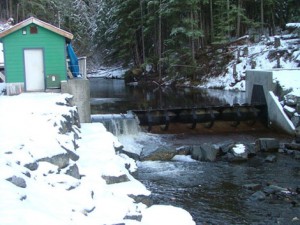Alaska Power and Telephone has purchased the Gustavus Electric Co. The 32-year-old homespun utility is the life’s work of Gustavus local Dick Levitt and his wife Linda.

AP&T President Bob Grimm says he has no plans to significantly change how the utility is operated. The one change Grimm mentions is that soon customers will be able to pay their bill with a credit card.
Regarding the sale of the utility, Grimm says he was first approached by Dick Levitt over a year ago.
“Eventually we came to an agreement and it included the hydro. Then we had to get all the regulatory approvals,” Grimm said. “We just finalized things up in July.”
Dick and his wife Linda made the choice to sell the utility because of Dick’s health. He suffered a stroke two years ago and hasn’t been able to manage the utility the same since.
“When the sale closed it was definitely mixed emotions for me,” Levitt said. “It was like giving up a child that I had raised. On the one hand I knew I had to give it up and get out of the business because of my health. And on the other hand I was still giving up something that was my life’s work. In that respect it was hard to see it go.”
Levitt is a trained electrical engineer, so when he saw an opportunity in Gustavus to start an electric utility, he went for it. The utility was created in 1982 and was diesel-based at first, but Levitt says he knew from the beginning that wasn’t going to be sustainable. Leavitt needed access to Falls Creek to bring hydropower to Gustavus and to do that he needed and act of Congress.
“Of course it was in Glacier Bay National Park which made it difficult,” Levitt said. “Probably in the mid-80s I started approaching the congressional delegation about legislation that would allow that to happen and it took close to 20 years to get that to come together. It was a long arduous process but we eventually got it done.”
Congress’s stamp of approval allowed the State of Alaska and the National Park Service to swap land, giving Leavitt access he needed to Falls Creek. Levitt prevailed when the Sierra Club protested the hydroplant during the Federal Energy Regulatory Commision’s approval process. The 800 kW hydroplant was finally completed in 2009.
Levitt says he hired AP&T as consultants on the design of the hydroplant, so he feels confident about their ability to maintain the facility.
The next hurdle for Gustavus Electric is to get the National Park Service in Glacier Bay as a customer. The park service still runs its facilities on diesel, despite efforts by Levitt to get them to switch. Grimm says convincing the park service to step away from fossil fuels is a priority.
Jennifer Canfield is a reporter at KTOO in Juneau.




